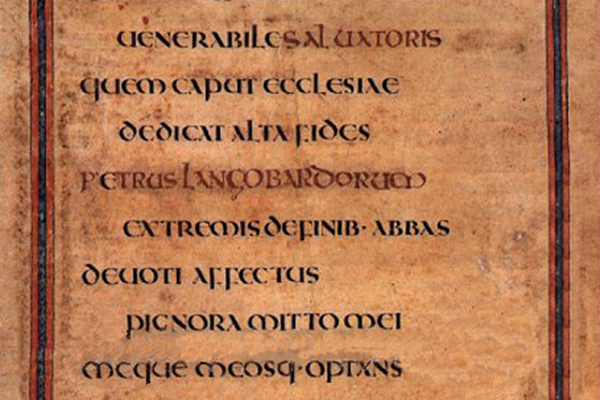

"...among other things he caused to be transcribed three bibles, two of which he [Ceolfrith] placed in the churches of the two monasteries, so that it should be easy for all who wished to read any chapter of either testament to find what they wanted; while the third he resolved to offer as a gift to Peter, Prince of the Apostles, when he was about to go to Rome."
Life of Ceolfrith
Of the three pandects (single-volume bibles) commissioned by Ceolfrith, abbot of the twin monasteries at Monkwearmouth and Jarrow in Northumbria (where Bede, himself, resided), the only one to survive intact is the Codex Amiatinus. Originally intended to be a gift to Pope Gregory II, it now is in the Biblioteca Medicea Laurenziana in Florence. Only a few leaves, which had been used as book wrappers, survive from one of the other two bibles. One, the Greenwell Leaf, is in the British Library.
Ceolfrith was seventy-four years old when, in AD 716, he began his pilgrimage to Rome. But the journey was long and, on the way, the old man died in Gaul near Dijon. Some of the monks who had accompanied him returned home to convey the news of his death; others stayed behind or continued on to Rome to present the abbot's gift.
The Codex Amiatinus comprises two thousand and sixty vellum pages (or half that number of leaves, with two pages front and back comprising a folio or leaf), which would have required the hides of some 1,550 calves. Each page measures some fourteen inches in width and twenty inches in height. The Codex, itself, is ten inches thick and weighs more than seventy-five pounds.
The elegant uncial (capital) script is written in two tall columns and follows the Vulgate of Jerome, of which the Codex is the oldest and best example. Ultra-violet photography shows the dedication page pictured above to be identical to the preface quoted in the anonymous Life of Ceolfrith, except that Petri and Ceolfridus Anglorum have been erased and Petrus Langobardorum, Peter of the Lombards, substituted to allow that abbot to present the massive tome as his own gift to the monastery of St. Savior (Salvatoris) at Monte Amiata near Siena.
Although not an illuminated manuscript, such as the Book of Kells or the Lindisfarne Gospels, the Codex Amiatinus has several full-page illustrations, the design of which were influenced by the Codex Grandior of Cassiodorus that had been brought to Monkwearmouth and Jarrow by Ceolfrith, himself, in AD 678 but now is lost. One such portrait, in turn, has an exact parallel in the Lindisfarne Gospels, demonstrating the close association between the two monasteries.